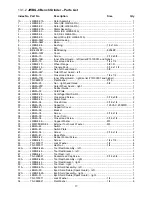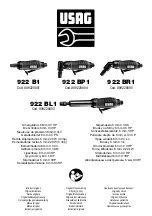
9
The tool rests must not contact the grinding wheel,
but should ideally be adjusted to within 1/16” of the
wheel, depending upon the type of tool being
ground. As a wheel wears down, the tool rest
should be readjusted to maintain this clearance.
Figure 4: completion of assembly
6.10
Grinding wheel selection
Abrasive wheels are generally designed around
five characteristics: material, wheel grade, grain
size, grain spacing, and type of bond. These codes
will usually be listed on a wheel’s label.
General-use silicon-carbide (carborundum) wheels
can overheat and ruin the temper of high quality
tool steel. For sharpening woodworking tools, an
aluminum oxide
wheel is recommended.
Always inspect an abrasive wheel before mounting.
(See
section 6.11, Ring test
.) A wheel that is
cracked or damaged in any way must
not
be used.
Maximum operating speed – listed on the abrasive
wheel label – must meet or exceed 1725 RPM
(grinder spindle speed).
6.11
Ring test
An internal defect, such as a crack or void, may not
be apparent by visual inspection alone. Before
installing a grinding wheel, check its internal
integrity by performing a simple “ring test”.
1. Suspend wheel from the hole by a small pin or
finger.
2. Gently tap the flat side of the wheel with a non-
metallic object, such as a wood dowel or the
handle of a screwdriver. Tap about 45° to each
side of vertical center line, and about 1” to 2”
from the periphery. Then rotate wheel 45° and
repeat.
3. A good wheel will "ring"; a defective wheel will
"thud", indicating cracks or other internal
compromise. Discard any wheel that does not
"ring".
A cracked or otherwise
damaged grinding wheel can break apart and, if
unguarded, exit grinder at high velocity
causing injury. Regularly inspect wheels for
damage, and make sure all guards are in
position.
6.12
Grinding wheel installation
Refer to Figure 5:
1. Unplug grinder from power source.
2. Move tool rest and eye shield out of the way.
3. Remove wheel guard.
4. Remove arbor nut (1” wrench) and outer
flange. (
NOTE: The left arbor nut has left-
hand threads; rotate clockwise to loosen.)
5. Make sure that inner flange is seated properly
against shoulder of arbor.
6. Install wheel, outer flange and nut. Make snug
the nut using the 1” wrench – do not
overtighten, as this may cause deflection of
the flanges.
7. Repeat for opposite side.
8. Inspect wheel for proper balance, as described
in
section 6.13
. An out-of-balance wheel will
result in excessive vibration and poor surface
finish of tools.
Figure 5: wheel mounting






































